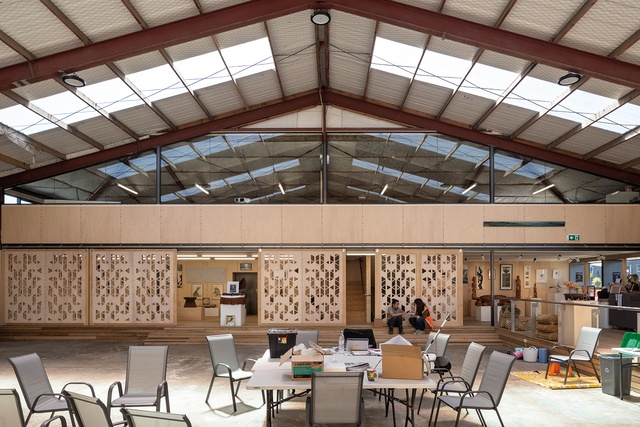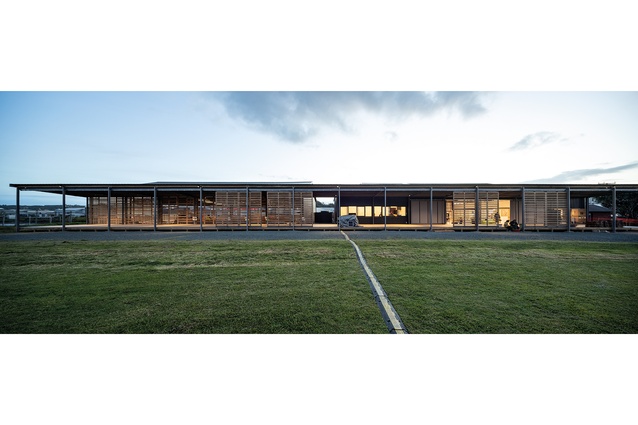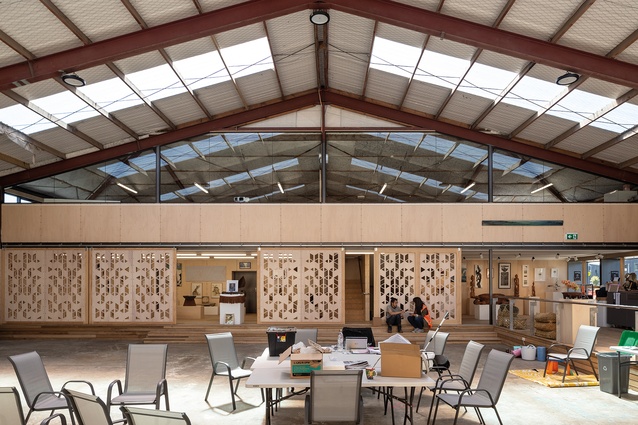Whare meets verandah
In the Hihiaua Cultural Centre by Moller Architects, Mike Austin finds an example of modest, bicultural architecture, which is well-grounded in the local.
About fifty years ago, in one of a collection of essays entitled The Māori People in the Nineteen-Sixties1, Bruce Biggs (author of the book Let’s Learn Māori2) stated that te reo would become restricted to formal occasions in the future and be used less and less in daily life. In the same publication, (Sir) Hugh Kāwharu had a paper that argued that there was no possibility of having new marae in cities other than those already established by the mana whenua.
Both prophecies turned out to be wrong. Te reo has flourished and urban maraes have been built in many places. The basis of Kāwharu’s proposition was that a marae required a local kin group (hapū or iwi) that, as tangata whenua, provided the source and maintenance of the kawa of the marae. He pointed out that an urban project would have no such group and that, therefore, marae would just become community or cultural centres.
Cultural centres have often been regarded as pie-in-the-sky dreaming, especially when favoured as student projects. However, the Hihiaua Cultural Centre in Whangārei is a highly successful contribution to the community and a significant example of bicultural architecture. The client is the Hihiaua Cultural Centre Trust, which has had this project in its sight for at least the last decade; not one of the several Whangārei hapū is in control and the job of the trust is the nurturing of Māori culture. This centre has Māori culture at its foundation but is open to others, in contrast to many other organisations that have Māori members in token roles while being structured along Pākehā organisational lines.
The Centre sits on a reclaimed peninsula at the confluence of two waterways. A riverside sculpture and heritage loop walkway lead past it, with plans, to go through it, perhaps, in the future. It sits alongside the town basin with water on three sides and this keeps the surrounding urban development and hills distanced from, but connected to, the building. The purpose of the building is to work with Māori youth, teaching carving and weaving, while the functions and spaces for them have varied and changed, so that the building is apparently in demand for all sorts of uses by all sorts of people and organisations. The plan is that the project is extended into a new performing arts building in the future.

The complex consists of three formal elements: a converted boat shed (whare toi), a new whare waka and a wide, covered deck joining them. The deck is more than the traditional mahau (a sheltered niche off the marae ātea). It is like a colonial verandah (an extension of the interior), running the full 60 metres of the two sheds sitting end to end. This makes the long façade appear almost classically Miesian. The deck is at sitting height above the ground and, at four metres wide, is generous enough to be used in a variety of ways – apparently two weddings have been held on it.
It avoids being a lean-to by the roof pitching back to a wide gutter on the sides of the existing sheds. Sliding-door track runs full-length on the outside edge, with screens that serve a variety of functions, from offering privacy to providing shade. There are four screens, each the width of one of the 14 bays; their hit-and-miss battens manage to preserve the openness of the project.
The whare toi, lit by clear plastic roofing, has been subdivided into two spaces, with one containing toilets and a lab/meeting room at the back. The larger space has a mezzanine housing a kitchen and meeting room. Below these are two rooms for display and weaving, with a timber floor raised above the concrete floor of the original shed and separated from it by perforated plywood sliding screens, again on full-length tracks. The apparent simplicity of this space is deceptive. It is carefully but not obsessively detailed, with spatial differences achieved by changes in floor and ceiling.

The exposed portal frames of the original shed of the whare toi (what a sensible way of spanning the ubiquitous portal frame) are continued in the new whare waka. However, the river-side wall is angled to align with the water’s edge. This means that the resulting diagonal ridge turns the gabled roof at one end to a shed roof at the other. This river side is completely open, spanned with a steel truss, and a gantry extends out over the Waiarohia Stream to launch canoes. The potential complexity of this is resolved with the gantry propped and strutted from the steelwork in a way that might offend structural purists but is solved in a relaxed display of Kiwi pragmatism such as we see on building sites all the time. Almost Gehry.
The wall between deck and whare waka is covered in vitex in various lengths and sizes with random gaps. Not quite random, because the idea is that the canoe-making activities in the shed can be observed through the gaps at all eye levels. The other two walls to the shed are 100mm x 50mm vertical battens at 200mm centres.
The result is an easy openness, with a restrained materials palette of steel and unfinished vitex timber. Inside the whare toi, blonded plywood is fixed with cups and screws everywhere. No Gib board. Nothing is done here for effect, and flashiness was specifically not wanted by the clients, nor is there a tokenistic use of Māori forms or decoration. The carving and weaving are activities rather than ornament. It is such a relief to see architecture not struggling for effect, intending instead to house. The job reportedly came in under budget. If Grand Designs is to be believed, it is the hugely expensive jobs that have endless difficulties with budgets. The architects worked collaboratively with the clients, not ruled by pretensions and obsessions.

Some of us dream of an architecture like this, grounded in the local. There has been some surprise that Moller Architects was the practice for this project, in what might be thought of as a Māori job. However, Moller has been a major contributor to the Aotearoa New Zealand architectural culture. Gordon Moller has been an editor of this journal and President of the Institute. For many of us, the Wellington coast bach was much admired and the original conversion of the Vivian Street Victoria University School of Architecture was always refreshing. SkyCity and Tower, which one would think would be a hard job to remain uncriticised for, has been (it seems) widely accepted as part of Auckland.
The tradition of modest but generous architecture continues here, in the Hihiaua Cultural Centre, with the work of Craig Moller. It is very appropriate that it was the winner of the John Scott Award for Public Architecture. Scott claimed the shed as a source for New Zealand architecture.
1 Erik Schwimmer (Ed.), The Māori People in the Nineteen-Sixties: A symposium, London, C. Hurst & Co, 1968.
2 Bruce Biggs, Let’s Learn Māori, Auckland University Press, 1969.















